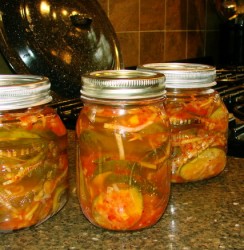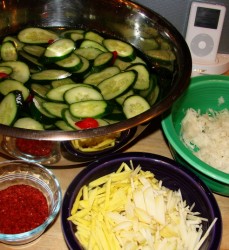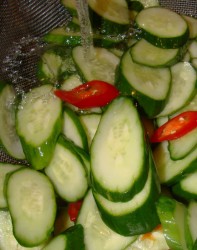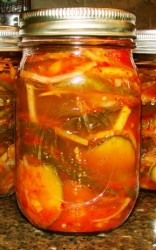East-West Fusion: Kimchi-Style Cucumber Pickles
I love pickles.
When I was a little kid, around five years old, my mother caught me drinking pickle juice right from the jar. This disturbed her greatly, not only because I had ruined a jar of pickles by putting my germy little lips on it, but, because she was sure that much acid was going to kill me.
I helped Grandma make many a batch of her dill pickles–my job was to scrub the heck out of the pickles before they went into the brine. When it was time to pack them into jars, my other job was to pick whole dill blossoms and peel whole cloves of garlic to put in the jars before Grandma squeezed the cukes in. The fragrant umbrels of dill looked like floral fireworks pressed against the glass of the jars, while the scent of garlic, vinegar and brine permeated my skin and hair, much to my delight.
As a pre-teen and a teen, one of my favorite snacks was a whole crisp, garlicky kosher dill pickle, fresh from the jar or barrel. I remember being impatient when it came to letting pickles age before nibbling on them, but when I did pick at them before their time, I found Grandma’s admonitions to leave them alone were right–young pickles are not always very good.
My love of pickles has diminished somewhat in adulthood, though I still love plenty of sour foods. I no longer drink pickle juice straight from the jar, but I will dig into my huge jar of spring kimchi and snag a choice morsel or two for a snack about every other day. Sometimes I will even eat that for breakfast;.
The last of cucumbers are in season, and are gloriously inexpensive, so I bought about three pounds of them at the farmers market with an eye to turn them into pickles. But what kind?
I nearly turned them into kimchi, but while I know that there are summer kimchi varieties made with cucumbers, they are meant to be eaten quickly, and are not meant for preservation and winter consumption. And I wanted to make pickles, but not plain old dill pickles.
So, I got the idea of making cucumber pickles with the flavorings that go into kimchi: ginger, garlic, fresh chilies, shredded, salted daikon, and dried Korean chile flakes.
(To find Korean chile flakes, try a Korean grocery or a general Asian market. The Asian market here in Athens keeps the Korean chile flakes in the refrigerated section. For reference, you can always print out the photo here of the chile and take it with you.)
I used a recipe that included a short brining time, because I was too impatient to let the pickles sit for a day, and because I didn’t really have a good place to leave them undisturbed where cats couldn’t get into them. This recipe was for sandwich pickles and included a heinous amount of sugar in it–sugar which, for the most part I left out. (I really, really dislike sweet pickles. They made me gag as a kid and to this day, tasting them still makes me shudder. I don’t know why, because it isn’t like I dislike sweet and sour flavor combinations. But something about sweet pickles—eech. It just gets to me.) I did leave a spare one tablespoon–and it didn’t so much as change flavor of the pickles as enhance them.
The first step I took was to peel and shred the daikon radish, which I then rubbed with about a teaspoon of salt, and let sit until much of the juice was drawn from the vegetable’s tissues.
That is the purpose of salting or brining when it comes to pickling, by the way–it helps remove excess water from the vegetable tissues. This does two things. First, the removal of some water gives the vegetable a crisper texture, and secondly, this slight dehydration process helps preserve the vegetable by means of making the vegetable a less hospitable place for bacteria. Salt, of course, also inhibits the growth of many harmful bacteria, so it also has a cleansing and preservative effect on its own, outside of its physical effects on the texture of the vegetable.
The cucumbers I sliced thinly on the diagonal–after obsessively scrubbing the somewhat muddy skins, of course–and tossed into a large stainless steel bowl with the thinly sliced serrano chiles and set them all to soak in brine (a solution of salt and water) for three hours.
While the cukes were brining and the daikon was leaching out excess water, I peeled and cut into very thin slivers four ounces each of garlic and ginger. I could have minced them up and that would have been easier, but I decided I liked the look of very thin slivers much better than a paste of ginger and garlic floating around in the pickle jars. Slicing tiny slivers is easy–you peel both the garlic and ginger, and then slice them into very thin slices. Then, you stake 3-5 slices on top of each other and then cut each stack into very thin strips. It is really easy once you get used to it, and when you must do a lot as I did, it becomes a moving meditation. I find such cutting relaxing.
After three hours, I drained the the cucumbers and chilies, and rinsed them well under cold running water, rubbing them with my hands to get the excess salt out of them. (I should have worn gloves for this, too, because all that salt is really not good for dry skin. Gee–maybe it is because of that dehydrating effect that salt on organic tissues? Hrm. Maybe.)
Then, it was time to make the pickling solution–I just poured the two vinegars, the water and the sugar into a pot, and brought it to a simmer over medium heat. When it started to boil, I poured in the Korean chile flakes, the ginger and the garlic and let it boil for about five minutes. This turned the solution a brilliant scarlet hue that kimchi-lovers know very well. and the fragrance once the ginger and garlic were added was delicious. I almost wanted to drink some right then and there.
But instead of that, I stirred the cucumber and chile slices into the pickling juice, and let them simmer for about five minutes.
Then, I packed them into hot jars, and as a final step, I added a bit of Ball’s Pickle Crisp to the top of the pickles, then screwed on the lids. Pickle Crisp, which is the proprietary name Ball gives to calcium chloride. Calcium chloride helps pickles retain their crisp texture by acting to firm up the natural pectins found in the cucumbers without also raising the pH level of the pickling liquid.
The most important thing you have to remember when packing pickles into jars, is to be obsessive about poking out excess air bubbles. Cucumbers are notorious for trapping pockets of air among themselves and between themselves and the glass of the jar. I have found, and was taught by Grandma to pack cucumbers fairly tightly, and after pouring in the hot brine, to use a thin spatula, a table knife or some other implement (a chopstick works pretty well) to poke around the pickles and down the sides of the jar to seek and destroy the air bubbles. After that, you just have to top up the vinegar solution while leaving the recommended empty space at the top of the jar.
Then, I just processed the jars for ten minutes. They all sealed perfectly, and I cannot wait to try the pickles!
But, wait I will. Pickles are not usually at their best when first made. They should really age a bit on a cool, dark shelf undisturbed. During this time, the flavors mellow and begin to cuddle with each other, becoming friendly. The vinegar loses its raw, sharp quality, the garlic snuggles up tot he ginger who kisses the cucumber, and the Korean chile pepper weaves all of these tastes and textures into a cohesive, spicy whole.
(Though, I have to admit that I tasted a couple of pickle slices before I started packing the jars. Even hot and fresh and new, the pickles tasted pretty darned good. They are also very spicy, so keep that in mind if you decide to make this recipe, and lower the amount of Korean chile flakes accordingly.)
Have no fear–when I open my first jar of these scarlet and pine colored wonders in a couple of weeks, I will write an update letting everyone know how they turned out.
Until then, here is the recipe, if you feel the need to experiment right along with me.
Kimchi-Style Cucumber Pickles
Ingredients:
1/2 cup kosher salt
8 cups cold water
3 pounds cucumbers, well scrubbed and sliced thin on the diagonal
4 serrano chiles, sliced thin on the diagonal
12 ounces daikon radish, peeled and shredded (I used the large holes on a plain old box grater to do this.)
1 tablespoon kosher salt
3 3/4 cups white vinegar
1 cup water
1 tablespoon raw sugar
1/4 cup Korean chile flakes
4 ounces fresh garlic, peeled and cut into fine shreds
4 ounces fresh ginger, peeled and cut into fine shreds
Method:
In a large stainless steel or glass bowl, stir salt into the water until it completely dissolves. Add cucumbers and chiles and allow to sit undisturbed for 3 hours. While this is going on, you can prepare the rest of the vegetables.
Massage the tablespoon of salt into the daikon radish and leave to sit in a bowl undisturbed for about an hour. After an hour, remove daikon and squeeze as much juice out of it as you can with your hands, until all that is left are fairly dry, crisp, lightly salty shreds of vegetable.
After three hours, drain the cucumbers and serranos and rinse the brine thoroughly off of them with very cold running water. (I rinsed, massaged, rinsed and rubbed for about eight minutes to get most of the salt off of the vegetables.) When you are finished, allow vegetables to drip dry in colander while you prepare the pickling solution.
In a saucepan or pot large enough to contain all of the cucumbers plus the pickling solution, bring the vinegar, water and sugar to a boil, stirring to dissolve the sugar all the way. Add Korean chile flakes and allow to boil gently for about ten minutes. Add the garlic and ginger, then add the cucumbers, chilies and daikon shreds, stirring to combine. Bring to a simmer and simmer about five minutes.
Pack into hot jars, being careful to pack the pickles in fairly tightly. Leave 1/2 inch of headspace at the top of the jar, then ladle pickling solution into the jars, leaving 1/2 inch of headspace at the top of the jar. If you wish, you may add 3/4 teaspoon of Pickle Crisp directly to the top of a pint jar after it has been filled with pickles and juice. (Use 1 1/2 teaspoons for a quart jar.)
Wipe the rim of the jar, center the lid and tighten the ring to finger-tightness–remember, not too tight. Continue filling jars until your pickles are all packed in.
Place on a rack in a hot water bath canner, with plenty of water to coverbring to a boil, boil covered for ten minutes. Turn off heat, remove lid from canner, and allow jars to sit submerged for five minutes. Then, remove from canner with jar lifter, set on a clean, folded dishtowel, and leave undisturbed until cool. Check seals, and if they are good, wipe down the jars, and tighten the rings, and store in a cool, dark place for at least two weeks before tasting.
Makes four pints or two quarts.
6 Comments
RSS feed for comments on this post.
Sorry, the comment form is closed at this time.
Powered by WordPress. Graphics by Zak Kramer.
Design update by Daniel Trout.
Entries and comments feeds.








This makes me so nostalgic for my grandmother’s pickles. She was from the South and taught me how to make watermelon pickles and pickled okra and pickled green beans. I loved vinegar, still do in fact but I don’t have your patience (or the room) to make my own pickles. After reading your blog today, I sure wish I had a bit more room in my tiny SF kitchen to store a nice shelf of home pickled goodies!
Comment by Nancy — October 9, 2007 #
Hey, i just made my very first successful Kimchi batch. I am so happy! I ve tried so many times and I always ended up with mold stinky cabbage. But today, it was different and I posted about my success. Kimchi Rocks!
Comment by Zlamushka — April 19, 2008 #
Hey guys! I cant wait to try my first batch of Kimchi. I’m going to give it try this weekend, and i’ll post how it goes…
Wish me luck!
Comment by Juicer — September 4, 2008 #
I just made two quarts. This is a great recipe and I cannot wait to eat them. I changed it around to use what I had. I put in onions instead of radish, and we will see how it goes. Thanks for the help.
Jeff
Comment by Jeff Jordan — August 3, 2009 #
Oh my gosh! I just made Zuni Cafe Zucchini Pickles which are your typical bread ‘n butter type. Now me being of almost forgotten Korean ancestry, I was just thinking the same thing about Kim Chee pickles. My own grandma was supposed to make kimchee that rivaled the best of the best, but that was centuries ago and all is lost. Ah me! I searched the internet for a kim chee pickle that I can manage and yours popped up. Looks delicious and I’m going to give this a try. Thank you!!!
Comment by Christine — August 24, 2012 #
I hope you enjoy them, Christine. I also have a couple of straight up kimchi recipes here you might like.
http://www.tigersandstrawberries.com/2007/04/30/up-close-and-personal-with-kimchi/
and
http://www.tigersandstrawberries.com/2008/09/29/its-kimchi-time-again/
Comment by Barbara — August 25, 2012 #